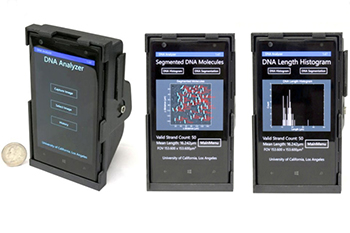
Imaging and sizing of single DNA molecules on a mobile phone. Credit: Ozcan Laboratory / UCLA
A team from the University of California, Los Angeles (UCLA), USA, has created a portable, smartphone-enabled microscope that can view single strands of DNA (ACS Nano, doi: 10.1021/nm505821y). The compact microscope attachment works with a computational framework and smartphone app to image and measure individual fluorescently labeled DNA molecules 10 kilobase pairs (kbp) or longer, with a 2 mm2 field of view. The authors believe that translating typically bulky and expensive benchtop DNA imaging equipment into a cost-effective, portable design will make medical diagnostics and genetic research more accessible to developing countries and resource-limited institutions.
The mobile microscopy platform weighs 190 grams and consists of a compact laser diode (450 nm, 75 mW), coverslip, miniature dovetail stage (for focusing the sample image), external lens and a filter for the smartphone lens. The laser excites fluorescently labeled DNA molecules underneath the coverslip; the image of the magnified DNA molecule is formed on the phone’s CMOS sensor-chip. The interference filters suppress background noise from the excitation beam, creating strong dark-field performance.
The team demonstrated measurement accuracy of less than 1 kbp for DNA strands 10 kbp and longer. This level of accuracy is suitable for investigating genetically linked diseases like Alzheimer’s and some cancers, as well as for informing research of DNA-protein interactions and gene mapping.
Aydogan Ozcan and his UCLA colleagues also designed the computer interface for the microscopy unit. A smartphone app communicates the raw images from the microscope with a back-end (cloud) server for quick digital processing. The resulting images can be viewed on the smartphone screen as well as remote PCs.
For strands 5kb in length, the microscopy unit does not work as well as traditional benchtop microscopes. This discrepancy stems from the limited spatial resolution and weak signal-to-noise ratio of smartphones, which could be resolved by switching the external lens to a higher numerical aperture. The authors also envision improving their imaging technique with special substrates—like plasmonic metal films or nanostructure arrays—to increase the fluorescent signal of the labeled DNA molecules.
The authors estimate the cost of their device to be US$400—significantly cheaper than traditional bench-top fluorescent microscopes. They also believe that the cost could be reduced with large-volume manufacturing.
